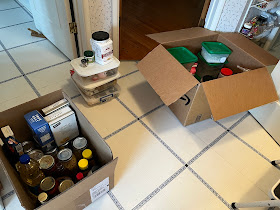Basically, it's a chunky latke. This version uses a chickpea batter in place of eggs, making this version vegan and slightly less expensive. I had been thinking of making a socca that day, so I was already in the mood for something like this. I made it as part of dinner, but it really works any time of day. Hot for breakfast. Leftovers would make a great cold lunch. A small slice at tea time.
It does take time to make. Potatoes have to be thoroughly cooked, and this one doesn't use the oven. You could make the onion and potatoes ahead of time, then mix with the batter when ready to cook. All in one shot, you're looking at a minimum of an hour.
1 C diced onion (1 small or 1/2 large)
1/4 C olive oil, plus more as needed for the pan
1 lb dense potato, such as Yukon or red
salt and pepper to taste
*1 C chickpea flour
1 C water
2. Warm the oil in a 12" skillet that has a lid over medium heat. Add diced onion and cook until softened, about 10 minutes. Stir often so it doesn't get fried and crispy. You may need to turn down the heat. We're going for a slow caramelization.
3. While that's happening, peel potatoes if desired. I skipped that. Slice into bite-sized pieces about 1/4" thick and uniform size, so they cook evenly. I chose to set the cut potato in water because I didn't know how long it would be sitting around. Not a necessary step. Add to skillet and turn up heat to medium-high. Lightly fry potatoes with the onions until cooked, stirring every 5 minutes or so. This will take up to half an hour. Once easily pierced with a fork, remove from heat and allow to cool 5 minutes, or refrigerate as a do-ahead.4. Stir together potato mixture with its oil and the chickpea batter. Season with salt and pepper. I used about half a teaspoon of salt and 1/4 tsp pepper, but these are the only seasonings. Use your best judgment.5. Place the skillet back over medium heat and lightly coat the bottom with more oil. Add potato batter and arrange in a neat layer. Cover and cook until set, about 10 minutes. The top can still be a little uncooked.6. Use a spatula to loosen the pancake from the bottom of the pan. Keep going until you can shake it. If it's really stuck, it probably isn't cooked yet. Set a plate on top of the pancake, commit to the flip, and turn everything over. Place the skillet back on the stove, coat with a touch more oil, and slide the tortilla back into it. Cover again and cook another 6-8 minutes.7. Transfer to a serving pate and cut into wedges, with anything from sour cream dip to hot sauce as a dressing.Difficulty rating :)












































